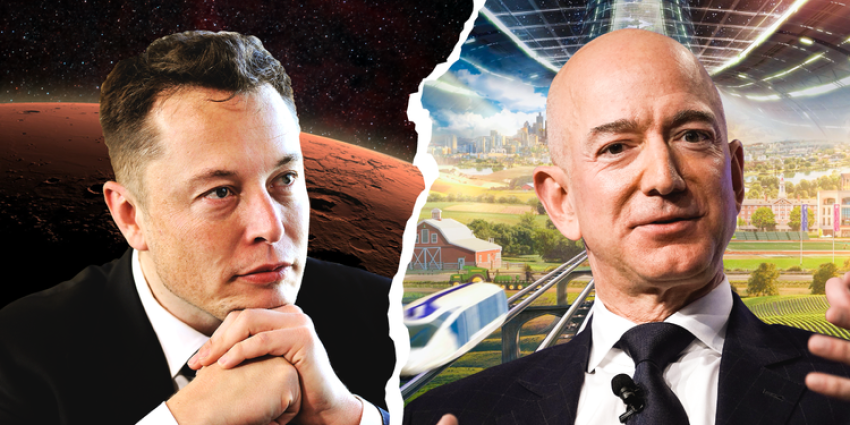
Let’s stop putting our hopes in billionaires like Elon Musk and Jeff Bezos to save humanity — they do not have the public welfare in mind. In reality, the billionaire class has benefited from the inequities of the capitalist system, and so is incapable and unwilling to change it.
Two events highlight the importance of understanding why the billionaire class is not our saviours.
In early July, Amazon marked its 25th anniversary of operations. Why is this significant?
Amazon, and its billionaire CEO Jeff Bezos, are held up as typical examples of the successful tech startup and a model of entrepreneurship.
Amazon, along with Apple, Facebook and Google, is a corporate behemoth, which has extended its operations around the world. IT is the area in which capital accumulation has resulted in the emergence of transnational corporations similar to the steel and railway industrial giants of the 19th and 20th centuries.
Bezos has become a household name, and his elevation to billionaire-celebrity status is indicative of the esteem in which he is regarded by the corporate media.
His achievement in making one of the largest corporations in the world is portrayed as the result of his unique motivation to succeed and entrepreneurial ingenuity.
Bezos began his rise after he left the hedge-fund world and started an early e-commerce business selling books. As of 2018, Amazon’s market capitalisation reached US$1 trillion.
Amazon workers’ strike
The second important event was the recent strike by Amazon workers. Thousands of Amazon workers in the company’s factories — euphemistically named wish fulfillment centres — stopped work on Prime Day, a shopping holiday created by the company for its Prime member customers.
While Bezos is one of the richest people in the world, his workers toil for long hours in exploitative conditions in poorly-paid jobs.
The Amazon workers’ strike is important because it punctures the aura of “human progress” that has surrounded Amazon’s meteoric rise.
The wealth that billionaires like Bezos enjoy today is not the result of the amazing intellect, drive to succeed or personal qualities of the entrepreneur. Amazon, and similar tech giants, became rich through the hard work and toil of thousands of workers.
Over the years, several undercover journalists have secured work at Amazon’s warehouse facilities and detailed the brutal, exploitative and humiliating working conditions endured by workers. Expected to perform tasks at lightning, split-second speeds, workers (called pickers) have to complete physically demanding schedules, and any slip-up, illness or injury results in accumulated penalties.
Dismissal of workers is frequent, because Amazon can recruit from a large pool of unemployed.
Innovative exploitation
Amazon and similar tech corporations are great at innovation — but in the area of exploitation.
Amazon has updated the field of labour management and refashioned a new Taylorism. Named after the founder of worker-management techniques, Frederick Taylor, the new Taylorism employs the latest technology to surveil and monitor worker performance.
Workers are constantly monitored, their walking speed measured, the seconds it takes for them to move from shelf to shelf, pack ordered items, register and send them all timed. These data metrics are used to penalise workers who are deemed too slow or inadequate.
Decades ago, Charlie Chaplin depicted assembly-line work in his movie Modern Times. While Chaplin performed for comedic effect, there is an element of truth about the robotic nature of factory work — a depiction that is still relevant today.
When Amazon workers demand that they be treated as people, not robots, it speaks volumes about the continuity of ‘scientific’ Taylorism — then and now.
The cult of the entrepreneur has elevated a number of obfuscatory myths about the current process of capitalist production.
Entrepreneurs are portrayed as courageous, innovative geniuses, who strive for the latest technologies and business efficiencies. This is usually contrasted with government-run industries and assets, which are routinely depicted as rigid, bureaucratic and resistant to innovation.
The public versus private dichotomy is ubiquitous, but false.
Myth of the all-powerful market
The technologies that tech companies such as Apple and Google use were developed by publicly-funded — that is, government subsidized — agencies and departments.
University College London economics professor Marianna Mazzucato wrote that government-funded departments have put in the research and technological innovations underlying much of our current systems today.
It is not just the algorithms and gadgets used by Google and Apple that were initially developed by government agencies, only to be privatised later.
The National Institute of Health (NIH) in the United States funds medical research and innovations in the life sciences to the tune of billions of dollars. The Human Genome Project would not have been completed were it not for the support of the NIH.
Even in the prime example of government-run industries, the former Eastern Bloc, government institutions innovated — not just in space research, but in health care, education and heavy industry.
The Soviets were not the first to land on the Moon, but they were the first — and last — to successfully land a spacecraft in the inhospitable and hostile environment of Venus.
Innovation is not the exclusive preserve of the private sector — but the latter is efficient at innovating new ways to spread rapacious individual consumerism.
Before placing our hopes in another round of billionaires promising to save us, it is time to dispense with the myth of the super-smart billionaire saviour.
While personal qualities of ingenuity and motivation are important, they are not the determining factors in wealth creation.
It is the work of thousands that made Amazon — and Apple, Google, Uber and the rest of them for that matter — the ultra-wealthy companies that they are today.
[Rupen Savoulian blogs at Antipodean Atheist, where this article first appeared.]